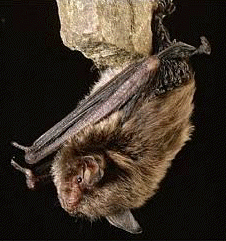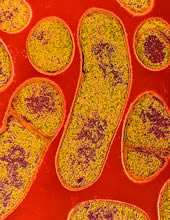|
|
|
|
 |
|
|
|
|
|
|
|
|
|
|
|
|
|
|
|
|
|
|
|
|
|
|
|
|
|
|
|
|
|
|
|
|
|
|
|
An OSU graduate student (Stella Luna) is studying the genetic relatedness
of the members of a population of Ozark Big-eared bats in a cave in eastern
Oklahoma. These bats spend the day inside the cave and leave at dusk to
forage for insects and drink water from a nearby stream. During the winter
months, both sexes can be found in the same cave (hibernaculum), however,
in June, the females group together in maternity caves where they give
birth to their young and stay with them until they are weaned. By the
end of November, they rejoin the males in the hibernaculum. Over a period
of 3 years, Stella has netted all the bats in a particular hibernaculum
and taken small pieces of skin from the wing membranes using a device
similar to a hole punch for paper. She will be able to obtain DNA from
the wing samples and a comparison of certain regions of the DNA will be
used in her genetic analyses. At the end of the first year of her study
Stella found a total of 60 bats in the hibernaculum. During the second
year of her study she recorded 26 births and 20 deaths. Stella also calculated
the area of the hibernaculum as 100 cubic meters.
|
|
|
|
|
|
|
|
Congenital Generalized Hypertrichosis (CGH) is an X-linked dominant trait
that results in excess facial and upper body hair that covers extensive
areas of skin. |
|
 |
| Dr. Marley, an instructor of Biology 1114, has been reading
about various diseases that affect equines (horses, zebras, etc.) because
he recently acquired a horse named Sassie. There are three types of Equine
Encephalomyelitis - Eastern, Western, and Venezuelan. The virus that results
in Eastern Equine Encephalomyelitis (EEE) is carried by small birds (primarily
house sparrows and house finches) in North America. The virus apparently
does not harm the birds. The EEE virus can be transmitted to humans or horses
by mosquitoes that feed on birds and then horses and humans. This infection
results in an inflammation of the brain and the spinal cord. The virus has
been isolated and a vaccine for prevention of the disease has been produced.
Veterinarians highly recommend that you vaccinate horses against this potentially
lethal disease. |
|
In a recent article published in
the Journal of Medical Entomology, a group of scientists in Massachusetts
were interested in determining the effect of the EEE virus on the survivorship
of three different species of mosquitoes. Female mosquitoes were allowed
to feed on anesthetized chicks that were infected with EEE. Mosquitoes were
then placed in cardboard containers covered with netting, provided corn
syrup as a food source, and monitored twice a day for a period of 2 weeks.
Infection with EEE significantly reduced survival in one species of mosquito.
The Eastern and Western forms of encephalomyelitis are not transmitted directly
from horse to horse. However, the Venezuelan virus is contagious. Not only
is it spread by mosquitoes from birds to other horses, but also it spreads
from horse to horse when they rub noses, or share water and feed containers.
|
|
|
|
|
|
|
|
Another concern of horse
owners is botulism. It is caused by toxins produced by the bacteria known
as Clostridium botulinum. C. botulinum is an anaerobic prokaryote that lives
in oxygen free pockets of soil. The bacteria are also capable of becoming
inactive and forming spores that can survive in the presence of oxygen.
Spores are sometimes found in the soil and on decaying plant or animal matter
and can be ingested when horses feed on dirty hay or eat in dirty feeding
locations. Once ingested the C. botulinum becomes active and produces a
powerful toxin that enters the blood stream and eventually moves into the
presynaptic axon terminals that synapse with muscles. The major feature
of botulism are muscle weakness or paralysis. Botulism can also occur when
deep puncture wounds are contaminated with Clostridium botulinum. |
|
|
|
While the research on the biological basis of human behavior still has most
of the story to unravel, interesting progress has been made in understanding
the genes that affect behavior through effects on reception of neurotransmitters.
One line of research is on the D4DR gene which appears to affect the probability
that a person will be a high novelty seeker or a low novelty seeker (Note
there are many other genes involved and the overall effect is highly affected
by environment and experience). When sequenced, the gene appears in two
forms - one much longer than the other. The gene codes for the receptor
for the neurotransmitter dopamine, which is released from axon bulbs in
the nucleus accumbens, the "pleasure center" of the brain. The
longer form of the gene results in a receptor on the dendrite that is less
able to bind with the dopamine. People with one or two long-forms of the
gene are more likely to seek stimuli that stimulate dopamine release because
they are less stimulated by dopamine than those with two short-forms of
the gene. |
|






